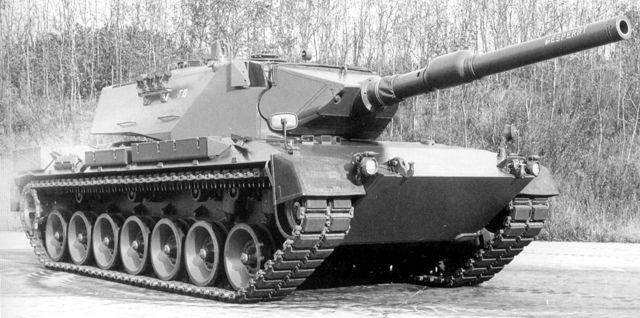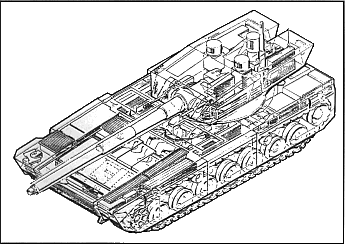-
Posts
244 -
Joined
-
Last visited
-
Days Won
18
Content Type
Profiles
Forums
Blogs
Gallery
Downloads
Events
Posts posted by FORMATOSE
-
-
-
105 mm Israeli APFSDS
????? = M111 Hetz-6 = DM23 = Pfeil Pat 78 Lsp = 33 mm Slpprj m/80 = DTW1-105 = FS Mk. 1
CL260 = M413 Hetz-7 = DM33 = PPTFS M/85 = FS Mk. 2
CL3108 = M429 = FS Mk. 2 Improved
??????? = M426 Hetz-10 = DM63 = Slpprj m/90C and Slpprj m/90S = FS Mk. 3 (unconfirmed)
- Collimatrix and That_Baka
-
 2
2
-
4 hours ago, Mighty_Zuk said:
QUESTION:
What tanks possess an automatic target tracking capability in their FCS?
The Japanese Type 90 and the French Leclerc (the latter is refered as a semi-automatic target tracker).
-
-
1 hour ago, chebuRUSHka said:
Fair enough. For me the Leopard 2K is just a rebrand. I fail to see any substantial difference besides the gun.
Different engine compartment in order to fit the new MB 873 Ka-500 engine (1500 hp) and its HSWL 354 transmission, type 570 tracks instead of the type 635.
On 21/02/2017 at 5:23 PM, chebuRUSHka said:I was wondering what were the Rh-105 penetration capabilities with 60s and 70s ammo?
I have a table listing the performance of a dozen of APFSDS ammunition against NATO targets at given ranges.
I'll post it later.
-
51 minutes ago, chebuRUSHka said:
Like i wrote there were different versions:
Two Keiler prototypes were produced from october 1969 and were trialed in 1970 :

A total of sixteen Leopard 2K prototypes were produced and tested between 1972 and 1975, seven of them were fitted with a 120 mm smoothbore gun :
 24 minutes ago, SH_MM said:
24 minutes ago, SH_MM said:Also note that there is not one Rh 105 gun, the name has been used for various different guns, but not officially for the gun you seem to be interested in.
I would add that this is family of five 105 mm rifled guns, with designations ranging from Rh 105-11 to Rh 105-60.
-
8 hours ago, chebuRUSHka said:
Yes. That tank was called Keiler. There was also a version with the 120mm L44. The interesting characteristic about the Keiler was its power-to-weight ratio. At only 40 tonnes this tank was carrying the mighty 1500hp engine from the Leo2, resulting in 37.5 hp/t.
It was armed with a 105 mm smoothbore gun and it was powered by the MB 872 Ka-500 engine developping up to 1250 horsepower, the Keiler weighed likely as much as the Leopard 2K prototypes ; between 46 800 kg and 50 500 kg.
-
3 hours ago, Mighty_Zuk said:
Pereh ATGM carrier was finally laid to rest yesterday (21/02/17) in a ceremony held by both active duty servicemen and reservists.
Proper replacement will be found.

So, it has been finally phased out of service. Do you have any official sources about this event ?
- Bronezhilet, MrMartin, Zyklon and 2 others
-
 5
5
-
Quote
After the introduction of the M1A1, some additional modifications were considered as Block product improvements. Approved by the Army Vice Chief of Staff on 1 February 1985 and reevaluated in August of that year, some of these changes were scheduled for incorporation into the M1A1 production tanks starting in late 1988. With these new features, the tank was nicknamed the M1A1+. Improved armor protection was obtained with a new special armor incorporating depleted uranium. This feature was introduced into the M1A1 production starting in October 1988. The new armor greatly increased the penetration resistance particularly against kinetic energy rounds.
On 14 December 1988, General Dynamics Land Systems Division was awarded a contract for the full scale development of the improved Abrams. Scheduled for fielding in 1992, this vehicle, to be designated as the 120mm gun tank M1A2.R. P. Hunnicutt, Abrams: A History of the American Main Battle Tank, Vol. 2
-
1 hour ago, chebuRUSHka said:
What's a MBT 78?
Likely related to the MBT-80.
-
15 minutes ago, chebuRUSHka said:
Was the armour of the M1A2 improved between 1986 and 1992?
You mean M1A1 ?
-
-
On 26/01/2017 at 1:28 PM, SH_MM said:
The US Army also had tank prototypes with only two men crew, which are not related to the NGP.

US tank design from 1993 with two men crew and unmanned turret.
I counted three :

-
AMX-30 M693 20mm autocannon superelevation (-8° to +40°) :

-
On 12/02/2017 at 8:55 PM, SH_MM said:
a 105 mm APFSDS round with 38 mm "core" (projectile most likely). No 105 mm APFSDS or APDS round with 38 mm core/projectile diameter entered service with the German Army, but there was an APFSDS round with 38 mm diameter for the 105 mm smoothbore gun of the original 10 Leopard 2 prototypes. This APFSDS round might be identical to the 120 mm DM13 APFSDS (same projectile diameter, same weight), but has a lower muzzle velocity. As there is no exact data on range and on which part of the tank is required to have this level of protection (hull front? turret front? 30° frontal arc?), this doesn't tell very much about the actual protection level.
Quantified data about this 105 mm smoothbore gun and its APFSDS are shown in the following table summarising the trilateral trials :







Tanks guns and ammunition.
in Ballistics Science Discussion
Posted
So, that was this strange-looking ballistic-capped HESH round which was presented at the 1976 British Army Equipment Exhibition.